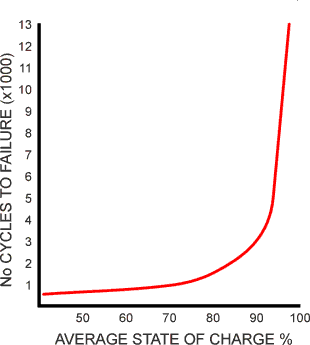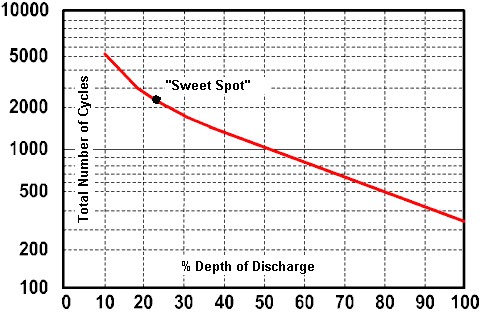
[Source: Adverc Battery Management]
Last Updated on February 10, 2008
The most important consideration in increasing the overall service life of a lead-acid battery is preventive maintenance. Please see Section 3 for more information on preventive maintenance. The typical life of a good quality, well maintained and properly charged battery is:
EXPECTED BATTERY SERVICE LIFE
|
Pasted Plate Car (used as a Deep Cycle) |
0 to 12 months |
|
Pasted Plate Car |
4 to 5 years |
|
Pasted Plate Marine/RV |
2 to 4 years |
|
Golf Cart (Motive) Deep Cycle |
3 to 5 years |
|
"L-16" (Motive) Deep Cycle |
7 to 10 years |
|
Gel Cell (Ca/Ca) VRLA (Motive) Deep Cycle |
to 8 years |
|
AGM (Ca/Ca) VRLA (Motive) Deep Cycle |
2 to 10 years |
|
Ni-Cad (Motive) Deep Cycle |
to 10 years |
Calcium Telecommunications (Stationary) Deep Cycle |
to 10 years |
|
Fork Lift (Motive) Deep Cycle |
10 to 20 years |
|
Manchex Industrial (Motive) Deep Cycle |
to 15 years |
|
Wet Standard (Sb/Sb) Industrial (Stationary) Deep Cycle |
to 20 years |
|
Ni-Fe (Stationary) Deep Cycle |
to 20 years |
Here are some tips to increase car or deep cycle battery service life:
11.1. Protecting your car battery from high underhood temperatures with a heat shield or case, keeping it full charged at all times, and maintaining it are the easiest ways to extend it's life. In hot climates and during summer, the electrolyte levels need to be checked more frequently. In a study conducted by the Society of Automotive Engineers (SAE), the underhood temperature has increased more than 30% since 1985. For every increase of 18° F (10° C) above 77° F (25° C), positive grid corrosion or self-discharge rate is doubled.
Chrysler studies have shown that relocating the battery outside the engine compartment has increased the average OEM battery life by eight months. Relocating the starting battery to the trunk or passenger compartment, as Mazda did in their Miata a number of years ago, is becoming more popular by the car manufacturers to protect the starting battery from the high underhood temperatures. However, use sealed AGM (Ca/Ca) or Gel Cell (Ca/Ca) VRLA type batteries because they normally do not produce gas when recharged or use wet batteries vented to the outside. If you use a Gel Cell (Ca/Ca) VRLA as a starting battery, you might have to lower the charging system voltages because they are very critical and to keep from overcharging the battery.
For motive and stationary deep cycle batteries, temperature is equally as important for extending the service life of the battery or battery bank. Common sense and chemical intuition suggest that the higher the temperature, the faster a given chemical reaction will proceed. Quantitatively this relationship between the rate a chemical reaction proceeds and its temperature is determined by the Arrhenius equation. Battery life, due to positive grid corrosion, is reduced by 50% for every 18° F (10° C) rise in ambient temperature over 77° F (25° C).
11.2. Periodically check the State-of-Charge of car batteries. Based on your driving habits, some vehicle charging systems undercharge the battery causing an accumulation of lead sulfate known as sulfation. This sulfation reduces the capacity of the battery. If the battery is not fully charged, recharge it periodically with an external battery charger matched to the battery type. Please see Section 9 for more information on charging and chargers and Section 16 for more information on sulfation.
In addition to temperature, car battery life and the number of charge and discharge cycles is dramatically influenced by the average State-of-Charge (SoC) as reflected in the following graph:
Car Battery Life

[Source: Adverc Battery Management]
If possible in a well ventilated area and at room temperature, recharge a deep cycle battery each day it is used and as soon as possible after each use. The best way to prevent permanent lead sulfation when a starting or deep cycle battery (or battery bank) is not in use, is to maintain it's State-of-Charge at 100% by continuous float charging. If continuous float charging is not possible, recharge before the State-of-Charge drops below 80%. Permanent sulfation kills approximately 85% of all deep cycle and starting lead-acid batteries not in weekly service. During hot weather, try and drive your vehicle at least once per week and in cold weather, once every two weeks. This is because batteries are perishable and the vehicle's parasitic (ignition key off) load and the natural self-discharge drain the battery. When the battery is not fully charged, sulfation occurs and the lead sulfate crystals will accumulate, harden and reduce the capacity of the battery. The same phenomenon occurs when a battery is undercharged or when electrolyte stratification occurs in larger wet lead-acid batteries. Please see Section 16. for more information on sulfation.
11.3. Reducing the average DoD (Depth-of-Discharge) and the number of discharge/charge cycles, by proper deep cycle battery or battery bank sizing will significantly increase a deep cycle battery service life. For example, a pasted plate wet battery with an average of 50% DoD will last twice as long or more as if it is has an 80% average DoD. A 20% DoD average battery can last up to five times longer than one with a 50% DoD average. Wet Golf cart batteries will typically have an average 225 cycles at 80% DoD and 750 cycles at 50% DoD. For more information of the "50% Rule", please see Chris Gibson's article on http://www.smartgauge.co.uk/50percent2.html. Always avoid Depth-of-Discharges that are greater than 80%. The "sweet spot" (optimum DoD for the greatest amount of power produced over the service life) is generally somewhere between 20% DoD and 60% DoD average. For the AGM (Ca/Ca) VRLA battery example below the "sweet spot" is approximately 22.5% DoD based on the greatest amount of power produced.
AGM (Ca/Ca) Life Cycles vs. Percent Depth-of-Discharge (DoD)

[Source: Concorde]
11.4. If required, equalize wet (flooded) and some AGM (Ca/Ca) batteries. Equalizing can also prevent electrolyte stratification, which can cause sulfation. Please see Section 9. for more information on equalizing batteries.
11.5. In extremely cold climates, keep the car battery continuously fully charged when not in use, the engine and battery warm, and use low viscosity synthetic engine oil. AGM (Ca/Ca) VRLA or Ni-Cad batteries work better in sub-zero temperatures than wet lead-acid batteries.
11.6. In hot climates use the "hot climate or "South" versions of car batteries. They have special plate and connecting strap formulations, lower Specific Gravity levels or increased the amounts of electrolyte to provide more "cooling" for longer service life. Using non-sealed Low Maintenance (Sb/Ca) car batteries is encouraged because you can add water. "Watering" is required more often in hot climates and add only distilled, demineralized or deionized water or, in a emergency, rain water. The plates must be covered at all times to prevent an internal battery explosion or sulfation. Do not overfill, and keep the top of the battery clean. Do NOT add electrolyte (battery acid) to a battery unless some electrolyte has spilled. If the Specific Gravity levels are increased beyond the battery manufacturer's recommended limit, the battery will exhibit a higher capacity level, but will require more maintenance and a have shorter overall service life. Please see Section 9.14 for more information on adding electrolyte or adjusting Specific Gravities.
11.7. Turning off all unnecessary accessories, rear window heater, climate control, and lights before starting your car will significantly decrease the load on the battery while cranking, especially when it is extremely cold.
11.8. Reducing the parasitic (key-off) load to below 75 milliamps.
11.9. In cold climates, increasing the diameter of the battery cables will reduce the voltage loss.
11.10. Never discharge any 12-volt lead-acid battery below 10.5 volts because it can damage the battery. An adjustable low voltage disconnect set for an 80% Depth-of-Discharge (DoD) or less can limit the maximum DoD and protect the batteries and electrical appliances. Leaving your lights or other accessories on and fully discharging a car battery can ruin it due to "cell reversal", especially if it is a sealed, wet Maintenance Free (Ca/Ca) type. Deep discharges in freezing weather will cause the battery to freeze and the expansion of the electrolyte can damage the plates, separators or even crack the battery case. If freezing should occur, you must let your battery thaw, physically inspect case for leakage, fully recharge it with a "smart" or "automatic" external charger matched the the battery type in a well ventilated area, remove the surface charge, and load test the battery and charging system to determine if there is any latent or permanent damage.
11.11. For vehicles not used weekly or driving habits that cause undercharged batteries, continuously float charge the car battery or fully recharge it periodically to remove the accumulated lead sulfate. Please see Section 13 for more information on storing batteries and Section 16 for more information on sulfation.
11.12. Provide adequate ventilation. High ambient temperatures above 80° F (or 26.7° C) will shorten battery life because it increases positive grid corrosion, growth and VRLA "thermal runaway".
11.13. Recharging slowly using the battery manufacturer's recommended temperature compensated voltages and procedures.
11.14. Avoid shallow (less than 10% DoD) discharges of deep cycle batteries because lead dioxide builds up on the positive plates. In other words, you should discharge a deep cycle battery between 90% and 20% Depth-of-Discharge.
11.15. Use batteries with thicker pasted or solid plates, thicker or tapered grids, and reduce the number of discharge-charge cycles. Each cycle removes a microscopic layer from the grid and eventually the upper portion of the grid can not carry the current.
11.16. Apply the correct battery type for the application, that is, starting for starting applications, motive deep cycle batteries for motive, and stationary deep cycle batteries for stationary applications. Please see Section 7.1 for more information on battery types.